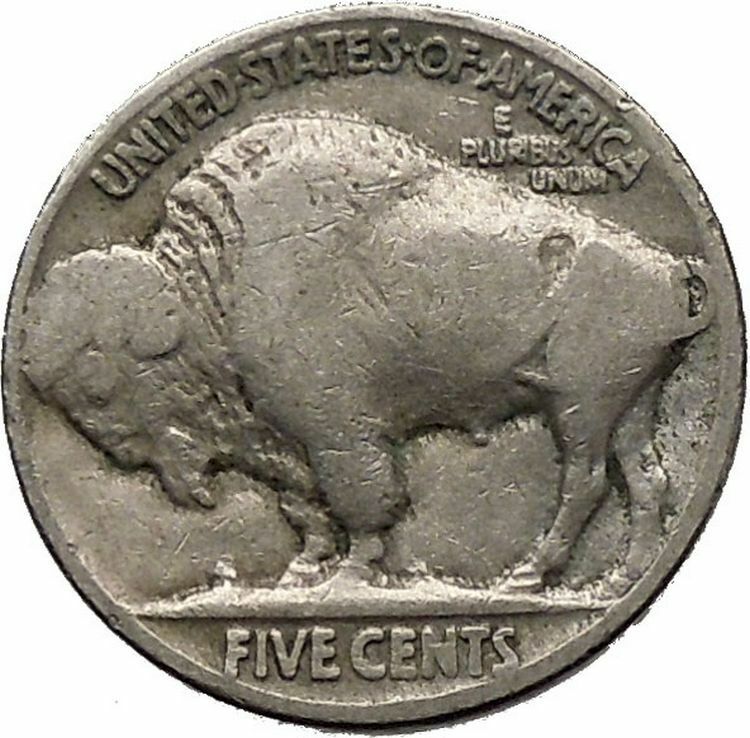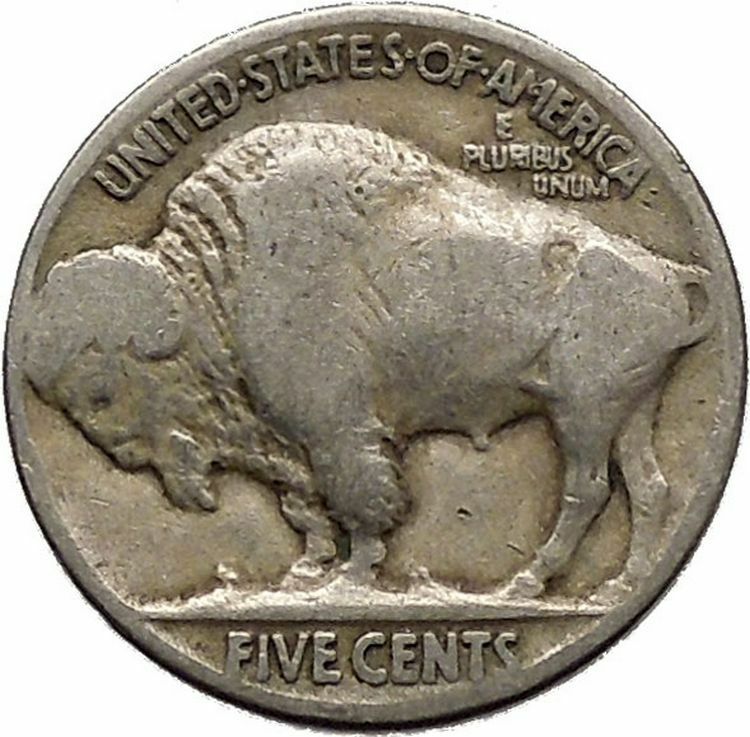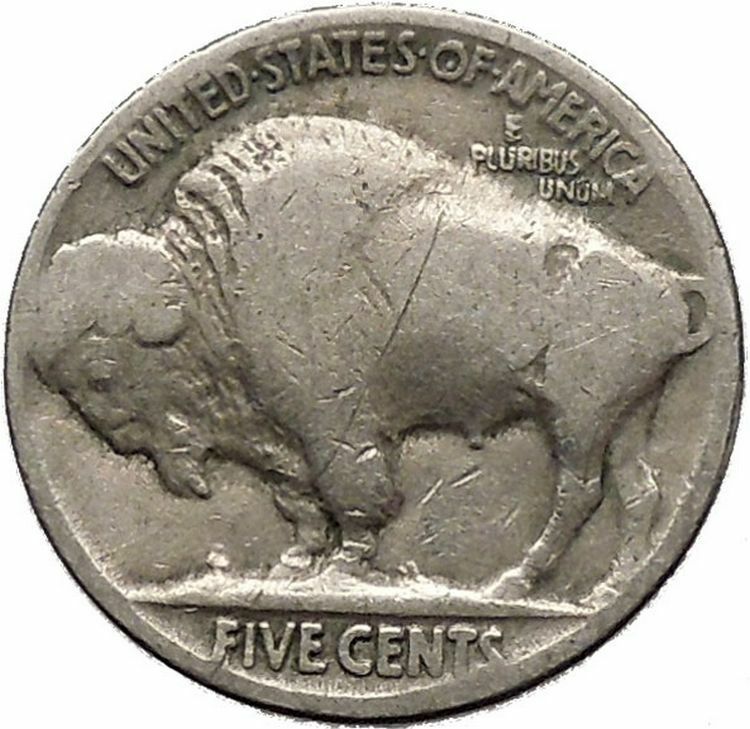|
United States of America
Buffalo Nickel
Five Cent Coin 21.21 mm (0.8350 in) in diameter 75% copper 25% nickel
1929 Head of American Indian right, LIBERTY to
right, initial of designer, F below date.
UNITED STATES OF AMERICA E PLURIBUS UNUM FIVE CENTS,
American
buffalo standing left.
James Earle Fraser designed this nickel, coming up with design from three models
of Native Americans. The bison from New York Central Park zoo called
“Black Diamond” is supposedly the model he used for this coin.
You are bidding on the exact
item pictured, provided with a Certificate of Authenticity and Lifetime
Guarantee of Authenticity.
The Buffalo nickel or Indian Head nickel was a
copper-nickel
five-cent piece
struck by the
United States Mint
from 1913 to 1938. It was
designed by sculptor
James Earle Fraser
.
As part of a drive to beautify the coinage, five denominations of US coins
had received new designs between 1907 and 1909. In 1911,
Taft administration
officials decided to
replace
Charles E. Barber
‘s
Liberty Head design
for the nickel, and
commissioned Fraser to do the work. They were impressed by Fraser’s designs
showing a
Native American
and an
American bison
. The designs were approved in
1912, but were delayed several months because of objections from the Hobbs
Manufacturing Company, which made mechanisms to detect
slugs
in nickel-operated machines. The company
was not satisfied by changes made in the coin by Fraser, and in February 1913,
Treasury Secretary
Franklin MacVeagh
decided to issue the coins
despite the objections.
Despite attempts by the Mint to adjust the design, the coins proved to strike
indistinctly, and to be subject to wear—the dates were easily worn away in
circulation. In 1938, after the minimum 25-year period during which the design
could not be replaced without congressional authorization had expired, it was
replaced by the
Jefferson nickel
designed by
Felix Schlag
.
Background
In 1883, the
Liberty Head nickel
was issued, featuring
designs by Mint Engraver
Charles E. Barber
. After the coin was released,
it was modified to add the word “CENTS” to the reverse because the similarity in
size with the
half eagle
allowed criminals to gild the new
nickels and pass them as five dollar coins. An Act of Congress, passed into law
on September 26, 1890 required that coinage designs not be changed until they
had been in use 25 years, unless Congress authorized the change. The act made
the current five-cent piece and
silver dollar
exceptions to the twenty-five
year rule; they were made eligible for immediate redesign. However, the Mint
continued to strike the Liberty Head nickel in large numbers through the first
decade of the 20th century.
President
Theodore Roosevelt
in 1904 expressed his
dissatisfaction with the artistic state of the American coinage, and hoped to
hire sculptor
Augustus Saint-Gaudens
to redesign all the
coins. Constrained by the 1890 act, the Mint only hired Saint-Gaudens to
redesign the cent and the four gold pieces. Saint-Gaudens, before his 1907
death, designed the
eagle
and
double eagle
, which entered circulation that
year; the cent,
quarter eagle
, and half eagle were designed by
other artists and released into circulation by 1909. By that time, the Liberty
Head nickel had been in circulation for more than 25 years, and was eligible for
redesign regardless of the special provision. In 1909, Mint Director
Frank Leach
instructed Barber to make pattern
coins for new nickels. Most of these coins featured the first president,
George Washington
. The press found out about
the pieces, and speculated they would be released into circulation by the end of
the year. The Mint received orders from banks in anticipation of the “Washington
nickel”. However, the project was discontinued when Leach left office on
November 1, 1909, to be replaced by
Abram Andrew
.
Andrew was dissatisfied with the just-issued
Lincoln cent
, and considered seeking
congressional authorization to replace the cent with a design by sculptor
James Earle Fraser
. While the change in the
cent did not occur, according to numismatic historian Roger Burdette, “Fraser’s
enthusiasm eventually led to adoption of the Buffalo nickel in December 1912”.
Inception
New design
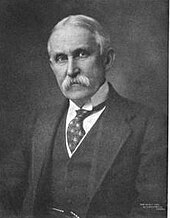
Franklin MacVeagh, Secretary of the Treasury under Taft. A letter to
him by his son may have been the genesis of the Buffalo nickel.
On May 4, 1911, Eames MacVeagh, son of
Treasury Secretary
Franklin MacVeagh
wrote to his father:
A little matter that seems to have been overlooked by all of you is the
opportunity to beautify the design of the nickel or five cent piece during
your administration, and it seems to me that it would be a permanent
souvenir of a most attractive sort. As possibly you are aware, it is the
only coin the design of which you can change during your administration, as
I believe there is a law to the effect that the designs must not be changed
oftener than every twenty-five years. I should think also it might be the
coin of which the greatest numbers are in circulation.
Soon after the MacVeagh letter, Andrew announced that the Mint would be
soliciting new designs for the nickel. Fraser, who had been an assistant to
Saint-Gaudens, approached the Mint, and rapidly produced concepts and designs.
The new Mint director, George Roberts, who had replaced Andrew, initially
favored a design featuring assassinated President
Abraham Lincoln
, but Fraser soon developed a
design featuring a Native American on one side and a bison on the other. Andrew
and Roberts recommended Fraser to MacVeagh, and in July 1911, the Secretary
approved hiring Fraser to design a new nickel. Official approval was slow in
coming; it was not until January 1912 that MacVeagh asked Roberts to inform
Fraser that he had been commissioned. MacVeagh wrote, “Tell him that of the
three sketches which he submitted we would like to use the sketch of the head of
the Indian and the sketch of the buffalo.” Roberts transmitted the news, then
followed up with a long list of instructions to the sculptor, in which he noted,
“The motto, ‘In God We Trust’, is not required upon this coin and I presume we
are agreed that nothing should be upon it that is not required.” Fraser
completed the models by June 1912, and prepared coin-size
electrotypes
. He brought the models and
electrotypes to Washington on July 10, where they met with the enthusiastic
agreement of Secretary MacVeagh.
Hobbs affair

Mint Director George E. Roberts (shown on his Mint medal) did his
best to bring the nickel to fruition despite the conflict between
Fraser and Hobbs.
In July 1912, word of the new design became publicly known, and coin-operated
machine manufacturers sought information. Replying to the inquiries, MacVeagh
wrote that there would be no change in the diameter, thickness, or weight of the
nickel. This satisfied most firms. However, Clarence Hobbs of the Hobbs
Manufacturing Company, of
Worcester, Massachusetts
requested further
information. According to Hobbs, his firm was the manufacturer of a device which
would detect counterfeit nickels inserted into vending machines with complete
accuracy. Discussions continued for most of the rest of 1912, with Hobbs
demanding various changes to the design, to which the artist was reluctant to
agree. When in December 1912, the Hobbs Company submitted a modified design for
the nickel, MacVeagh strongly opposed it. On December 18, Roberts officially
approved Fraser’s design, and the sculptor was authorized to complete and
perfect the design, after which he would be paid $2,500 (US$61,100
with inflation) for his work.
On January 7, 1913, Fraser’s approved design was used to strike experimental
pieces; the sculptor later wrote that he remembered several of the workmen
commenting that the new piece struck more easily than the old. Afterwards,
Roberts asked Fraser if the Hobbs Company was content with the design. The
sculptor told the Mint director that the firm wanted changes made, and Fraser
agreed to meet with them further. Over the following two weeks, Fraser worked
with George Reith, the Hobbs Company’s mechanic who had invented the anti-slug
device, in an attempt to satisfy the firm’s concerns. On January 20, Fraser
wired the Mint from his studio in New York, announcing that he was submitting a
modified design, and explained that the delay was “caused by working with
inventor until he was satisfied”. The next day,
Philadelphia Mint
Superintendent John Landis
sent Roberts a sample striking of the revised design, stating, “the only change
is in the border, which has been made round and true”.
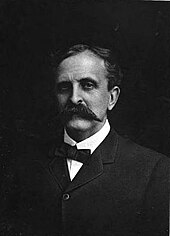
Clarence W. Hobbs. Objections by his firm delayed the Buffalo nickel
for months.
Despite the apparent agreement, the Hobbs Company continued to interpose
objections. Engraver Barber was asked for his view; he stated that Reith, who
had attended the trial striking, had been given all the time and facilities he
had asked for in testing the new pieces, and the mechanic had pronounced himself
satisfied. Hobbs Company agent C. U. Carpenter suggested that Reith had been
intimidated by the preparations that had already gone into the issue of the
modified nickel, “and, instead of pointing out clearly just what the situation
demanded, agreed to adapt our device to the coin more readily that he was
warranted in doing”. On February 3, Hobbs sent Roberts a lengthy list of changes
that he wanted in the coin, and the sculptor was required to attend a conference
with Hobbs and Reith. On the fifth, following the conference, which ended with
no agreement, Fraser sent MacVeagh a ten-page letter, complaining that his time
was being wasted by the Hobbs Company, and appealing to the Secretary to bring
the situation to a close. MacVeagh agreed to hold a meeting at his office in
Washington on February 14. When the Hobbs Company requested permission to bring
a lawyer, Fraser announced he would be doing the same. The Hobbs Company sought
letters of support from the business community, with little success; Fraser’s
efforts to secure support from artists for his position were more fruitful.
Barber prepared patterns showing what the nickel would look like if the changes
demanded by Hobbs were made. MacVeagh conducted the meeting much like a legal
hearing, and issued a letter the following day.
The Secretary noted that no other firm had complained, that the Hobbs
mechanism had not been widely sold, and that the changes demanded—a clear space
around the rim and the flattening of the Indian’s cheekbone—would affect the
artistic merit of the piece.
It is of course true that only the most serious business considerations
should stand in the way of the improvement of the coinage, and this
particular coin has great claims of its own, because of its special quality.
If we should stop new coinage—which is always allowed every twenty-five
years—for any commercial obstacles less than imperative, we should have to
abandon a worthy coinage altogether. This would be a most serious handicap
to the art of the Nation, for scarcely any form of art is more influential
than an artistic coin, where the coin is widely circulated.
You will please, therefore, proceed with the coinage of the new nickel.
After he issued his decision, MacVeagh learned that the
Hudson & Manhattan Railroad Company
, which
Hobbs claimed had enthusiastically received his device, was actually removing it
from service as unsatisfactory. The Secretary’s decision did not end the Hobbs
Company efforts, as the firm appealed to President
Taft
. With only two weeks remaining in his
term, the President was not minded to stop the new nickel (production of which
had started on February 18) and MacVeagh wrote to Taft’s secretary,
Charles D. Hilles
, “Certainly Hobbs got all the
time and attention out of this administration that any administration could
afford to give to one manufacturing corporation.” Numismatic historian and coin
dealer
Q. David Bowers
describes the Hobbs matter as
“much ado about nothing from a company whose devices did not work well even with
the Liberty Head nickels”.
Release and production
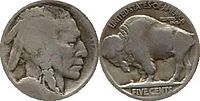
A dateless coin, showing the effects of circulation on the Buffalo
nickel. This is a Type II reverse.
The first coins to be distributed were given out on February 22, 1913, when
Taft presided at groundbreaking ceremonies for the
National American Indian Memorial
at
Fort Wadsworth
,
Staten Island, New York
. The memorial, a
project of department store magnate
Rodman Wanamaker
, was never built, and today
the site is occupied by an
abutment
for the
Verrazano-Narrows Bridge
. Forty nickels were
sent by the Mint for the ceremony; most were distributed to the Native American
chiefs who participated. Payment for Fraser’s work was approved on March 3,
1913, the final full day of the Taft administration. In addition to the $2,500
agreed upon, Fraser received $666.15 (US$15,900
with inflation) for extra work and expenses through February 14.
The coins were officially released to circulation on March 4, 1913, and
quickly gained positive comments as depicting truly American themes. However,
The New York Times
stated in an editorial
that “The new ‘nickel’ is a striking example of what a coin intended for wide
circulation should not be …[it] is not pleasing to look at when new and shiny,
and will be an abomination when old and dull.”
The Numismatist
, in March and May 1913
editorials, gave the new coin a lukewarm review, suggesting that the Indian’s
head be reduced in size and the bison be eliminated from the reverse.
With the coin now in production, Barber monitored the rate at which dies were
expended, as it was the responsibility of his Engraver’s Department to supply
all three mints with working dies. On March 11, 1913, he wrote to Landis that
the dies were being used up three times faster than with the Liberty Head
nickel. His department was straining to produce enough new dies to meet
production. In addition, the date and denomination were the points on the coin
most subject to wear, and Landis feared the value on the coin would be worn
away. Barber made proposed revisions, which Fraser approved after being sent
samples. These changes enlarged the legend “FIVE CENTS” and changed the ground
on which the bison stands from a hill to flat ground. According to data compiled
by numismatic historian David Lange from the
National Archives
, the changes to what are
known as Type II nickels (with the originals Type I) actually decreased the die
life. The new Treasury Secretary,
William G. McAdoo
, wanted further changes in
the coin, but Fraser had moved on to other projects and was uninterested in
revisiting the nickel. The thickness of the numerals in the date was gradually
increased, making them more durable; however the problem was never addressed
with complete success, and even many later-date Buffalo nickels have the date
worn away.
The Buffalo nickel saw minor changes to the design in 1916. The word
“LIBERTY” was given more emphasis and moved slightly; however many Denver and
San Francisco issues of the 1920s exhibit weak striking of the word, the Denver
issue of 1926 especially; Bowers questions whether any change was made to the
portrait of the Indian, though
Walter Breen
in his reference work on United
States coins states that Barber made the Indian’s nose slightly longer.
According to Breen, however, none of these modifications helped, with the coin
rarely found well-struck and with the design subject to considerable wear
throughout the remainder of its run. The bison’s horn and tail also posed
striking problems, again with the Denver and San Francisco issues of the 1920s
in general, and 1926-D in particular, showing the greatest propensity for these
deficiencies.
The piece was struck by the tens of millions, at all three mints (Philadelphia,
Denver
and
San Francisco
), through the remainder of the
1910s. In 1921, a recession began, and no nickels at all were struck the
following year. The low mintage for the series was the 1926-S, at 970,000 — the
only date-mint combination with a mintage of less than 1 million. The second
lowest mintage for the series came with the 1931 nickel struck at the
San Francisco Mint
. The 1931-S was minted in a
quantity of 194,000 early in the year. There was no need for more to be struck,
but Acting Mint Director
Mary Margaret O’Reilly
asked the San Francisco
Mint to strike more so that the pieces would not be hoarded. Using materials on
hand, including the melting down of worn-out nickels, San Francisco found enough
metal to strike 1,000,000 more pieces. Large quantities were saved in the hope
they would become valuable, and the coin is not particularly rare today despite
the low mintage.
A well-known variety in the series is the 1937–D “three-legged” nickel, on
which one of the buffalo’s legs is missing. Breen relates that this variety was
caused by a pressman, Mr. Young, at the
Denver Mint
, who in seeking to remove marks
from a reverse die (caused by the dies making contact with each other),
accidentally removed or greatly weakened one of the animal’s legs. By the time
Mint inspectors discovered and condemned the die, thousands of pieces had been
struck and mixed with other coins.
Another variety is the 1938-D/S, caused by dies bearing an “S” mintmark being
repunched with a “D” and used to strike coins at Denver. While the actual course
of events is uncertain, Bowers is convinced that the variety was created because
Buffalo nickel dies intended for the San Francisco mint were repunched with the
“D” and sent to Denver so they would not be wasted—no San Francisco Buffalo
nickels were struck in 1938, but they were produced at Denver, and it was
already known that a new design would be introduced. The 1938-D/S was the first
repunched mintmark of any US coin to be discovered, causing great excitement
among numismatists when the variety came to light in 1962.
When the Buffalo nickel had been in circulation for the minimum 25 years, it
was replaced with little discussion or protest. The problems of die life and
weak striking had never been solved, and Mint officials advocated its
replacement. In January 1938, the Mint announced an open competition for a new
nickel design, to feature early President
Thomas Jefferson
on the obverse, and
Jefferson’s home,
Monticello
on the reverse. In April,
Felix Schlag
was announced as the winner. The
last Buffalo nickels were struck in April 1938, at the Denver Mint, the only
mint to strike them that year. On October 3, 1938, production of the
Jefferson nickel
began, and they were released
into circulation on November 15.
Design, models, and name controversy
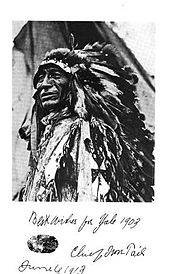
Chief Iron Tail
,
Oglala Lakota
, circa 1912
In a 1947 radio interview, Fraser discussed his design:
Well, when I was asked to do a nickel, I felt I wanted to do something
totally American—a coin that could not be mistaken for any other country’s
coin. It occurred to me that the buffalo, as part of our western background,
was 100% American, and that our
North American Indian
fitted into the
picture perfectly.
The visage of the Indian which dominates Fraser’s obverse design was a
composite of several Native Americans. Breen noted (before the advent of the
Sacagawea dollar
) that Fraser’s design was the
second and last US coin design to feature a realistic portrait of an Indian,
after Bela Pratt
‘s
1908 design
for the
half eagle
and
quarter eagle
.
The identity of the Indians whom Fraser used as models is somewhat uncertain,
as Fraser told various and not always consistent stories during the forty years
he lived after designing the nickel. In December 1913, he wrote to Mint Director
Roberts that “[b]efore the nickel was made I had done several portraits of
Indians, among them
Iron Tail
,
Two Moons
, and one or two others, and probably
got characteristics from those men in the head on the coins, but my purpose was
not to make a portrait but a type.”

Fraser’s design was adapted for a 2001 commemorative
silver dollar
. The mound is similar
to the Type I reverse initially used in 1913.
By 1931, Two Guns White Calf, son of the last
Blackfoot
tribal chief, was capitalizing off
his claim to be the model for the coin. To try to put an end to the claim,
Fraser wrote that he had used three Indians for the piece, including “Iron
Tail, the best Indian head I can remember. The other one was Two
Moons, the other I cannot recall.” In 1938, Fraser stated that the three Indians
had been “Iron
Tail, a Sioux,
Big Tree
, a Kiowa, and
Two Moons
, a Cheyenne”. Despite the sculptor’s
efforts, he (and the Mint) continued to receive inquiries about the identity of
the Indian model until his 1953 death.
Nevertheless,
John Big Tree
, a
Seneca
, claimed to be a model for Fraser’s
coin, and made many public appearances as the “nickel Indian” until his 1967
death at the age of 92 (though he sometimes alleged he was over 100 years of
age).
Big Tree
was identified as the model for the
nickel in wire service reports about his death, and he had appeared in that
capacity at the Texas Numismatic Association convention in 1966. After
Big Tree
‘s death, the Mint stated that he most
likely was not one of the models for the nickel. There have been other
claimants: in 1964, Montana Senator
Mike Mansfield
wrote to Mint Director
Eva B. Adams
, enquiring if Sam Resurrection, a
Choctaw
was a model for the nickel. Adams wrote
in reply, “According to our records, the portrait is a composite. There have
been many claimants for this honor, all of whom are undoubtedly sincere in the
belief that theirs is the one that adorns the nickel.”

Reverse of the American Buffalo gold coins, struck beginning in 2006
According to Fraser, the animal that appears on the reverse is the
American bison
Black Diamond
. In an interview published in the
New York Herald
on January 27, 1913, Fraser
was quoted as saying that the animal, which he did not name, was a “typical and
shaggy specimen” which he found at the
Bronx Zoo
. Fraser later wrote that the model
“was not a plains buffalo, but none other than Black Diamond, the contrariest
animal in the Bronx Zoo. I stood for hours … He refused point blank to permit
me to get side views of him, and stubbornly showed his front face most of the
time.” However, Black Diamond was never at the Bronx Zoo, but instead lived at
the
Central Park Zoo
until he was sold and
slaughtered in 1915. Black Diamond’s mounted head is still extant, and has been
exhibited at coin conventions. The placement of Black Diamond’s horns differs
considerably from that of the animal on the nickel, leading to doubts that Black
Diamond was Fraser’s model. One candidate cited by Bowers is Bronx, a bison who
was for many years the herd leader of the bison at the Bronx Zoo.
From its inception, the coin was referred to as the “Buffalo nickel”,
reflecting the American colloquialism for the North American bison. As the piece
is 75% copper and 25% nickel, prominent numismatist Stuart Mosher objected to
the nomenclature in the 1940s, writing that he was “uncertain why it is called a
‘Buffalo nickel’ although the name is preferable to ‘Bison copper'”. The
numismatic publication with the greatest circulation,
Coin World
, calls it an Indian head nickel,
while
R.S. Yeoman
‘s
Red Book
refers to it as an “Indian Head or
Buffalo type”.
In 2001, the design was adopted for use on a commemorative silver dollar. In
2006, the Mint began striking
American Buffalo
gold bullion pieces, using a
modification of Fraser’s Type I design.
See also
- The
Nickel Trophy
, an over-sized Indian Head
nickel awarded to winners of the (now defunct) annual football game between
the
North Dakota State Bison
and the
University of North Dakota
Fighting Sioux
- Hobo nickel
, artistically carved nickels
created during the
Great Depression
|












